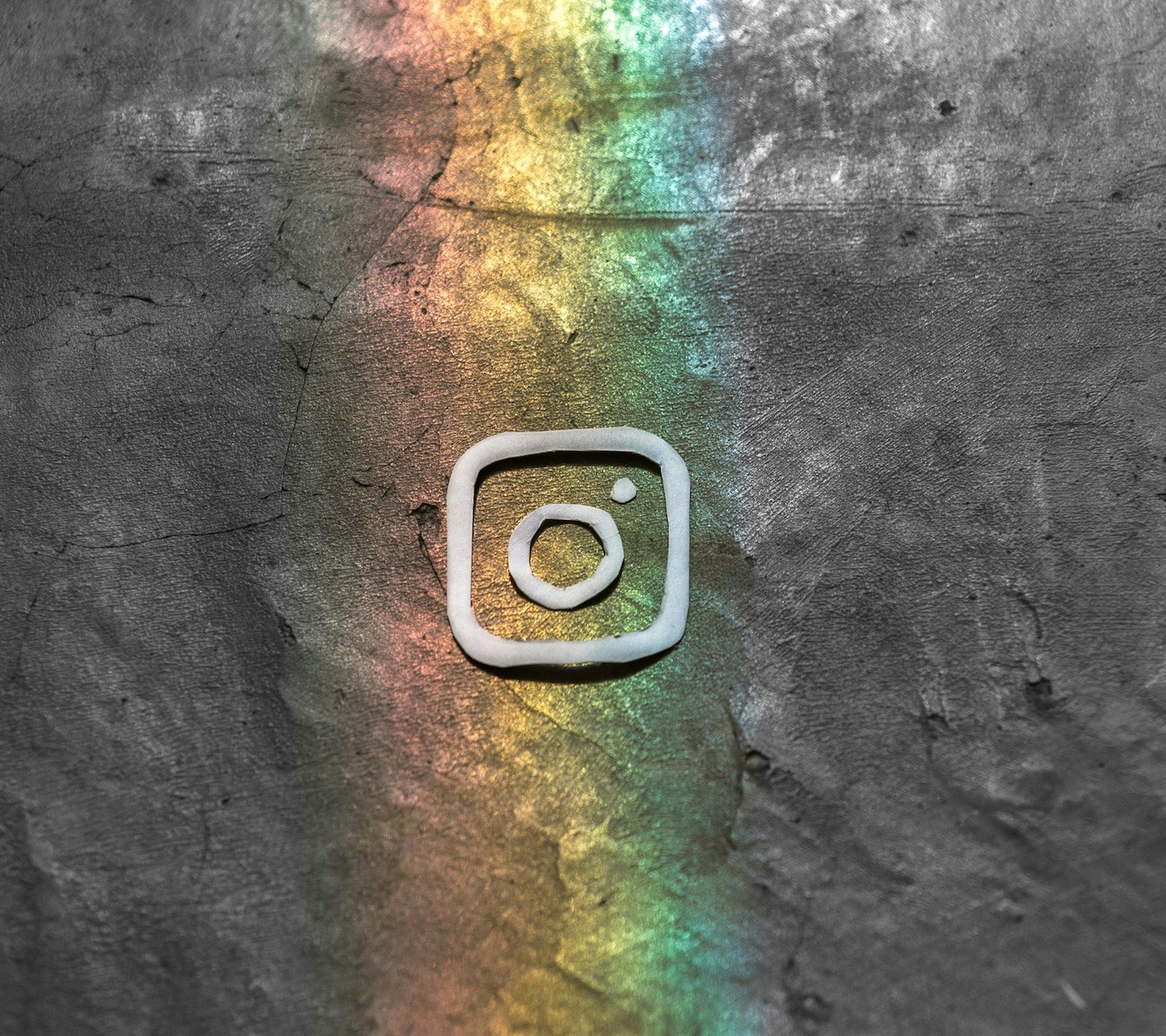Instagram marketing is essential to ecommerce businesses.
Not using Instagram to promote your products would be like a carpenter deciding wood saws just aren’t that useful.
Crazy.
Especially when you consider that more than 500 million Instagram users use the platform daily and 50% of them follow at least one business. .
Plus, Instagram is hell-bent on moving deeper into ecommerce.
Whether it’s the constant Instagram Shop updates or the introduction of a checkout button, it’s clear that ecommerce stores must keep up or risk being left behind.
But what exactly is an Instagram Shop, how will it help you grow your business, and how can you set one up?
Read on to find out.
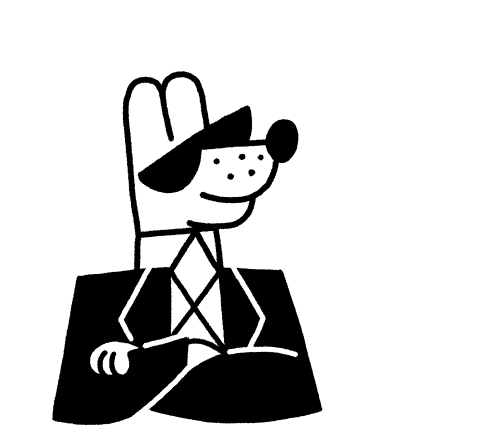
Did you know you can sync your Instagram and Facebook sales with your Shopify store? Build, track, and manage all your campaigns in one place. Live that omnichannel life.
GET A FREE TRIALWhat is an Instagram Shop?
An Instagram Shop lets you integrate your product catalog with your Instagram profile. In turn, this allows you to promote your products directly to Instagram users through posts, Stories, in the Explore tab, and in a special Shop tab on your profile.
Let’s look at some examples of how Instagram Shops work.
The image below features watch brand MVMT and shows the Instagram Shop tab in action. This allows users visiting their profile to see all of their products without leaving the Instagram app.
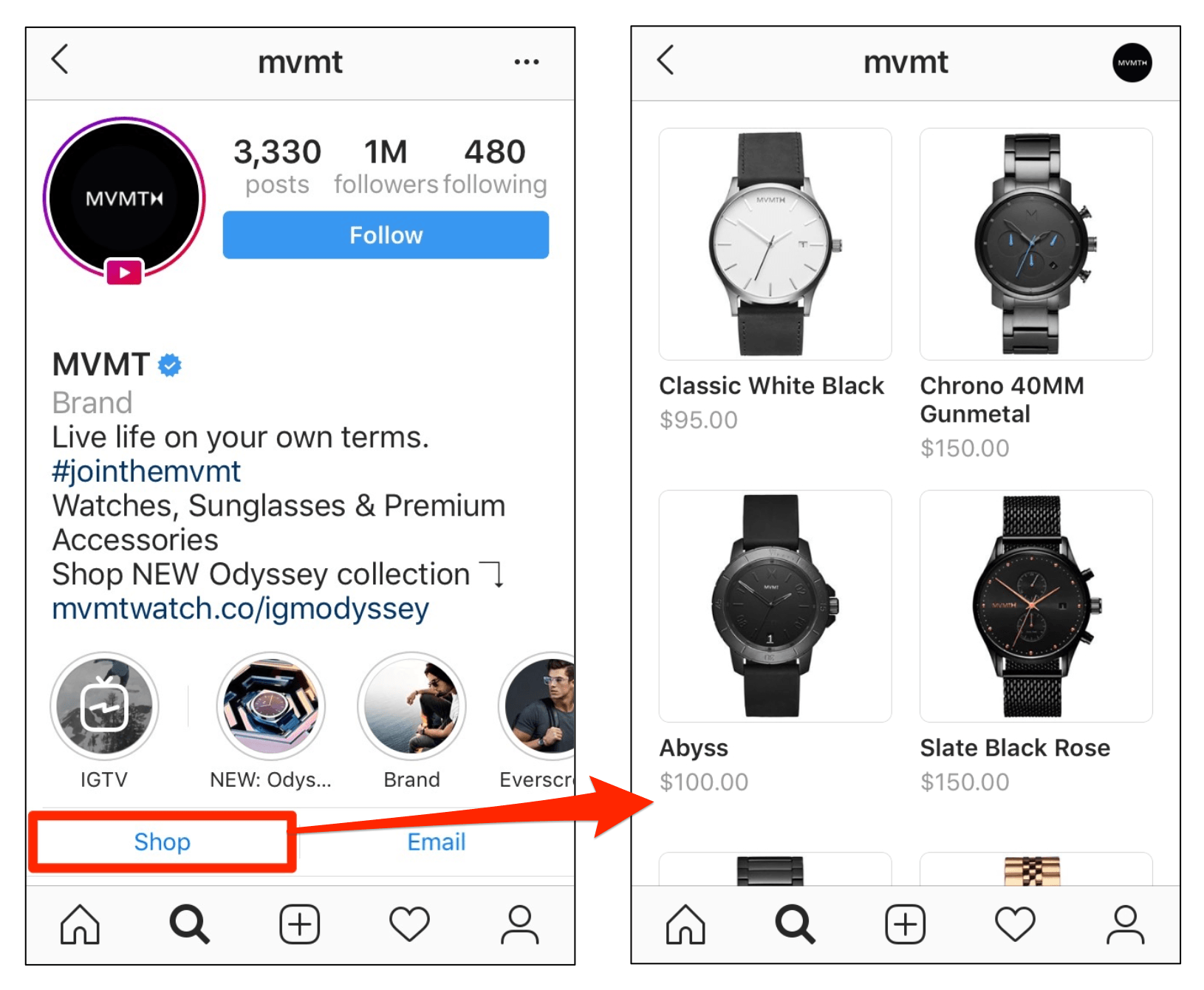
You can also tag Instagram Shop products in your posts in the same way you would tag a friend.
This adds a little shopping bag icon to your image.
Then, when users tap the photo, they can view the prices of the products featured and tap the product labels to view product pages.
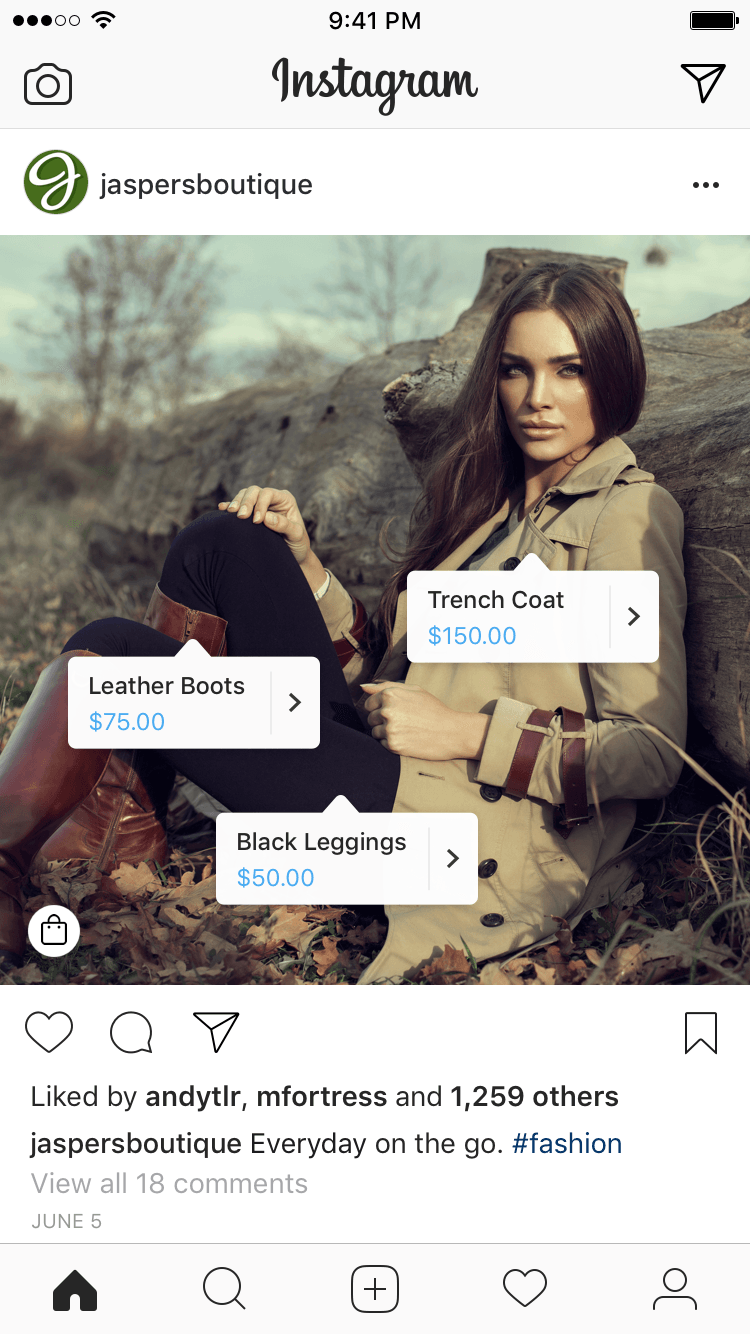
You can tag up to five items per image or twenty items per carousel.
Every time you tag an image with your products, that content will appear in an exclusive shopping feed on your Instagram business profile.
You can even promote your products in Instagram Stories
The image below shows a user viewing a Story, tapping a product sticker to get more information about the product, and then making a purchase.
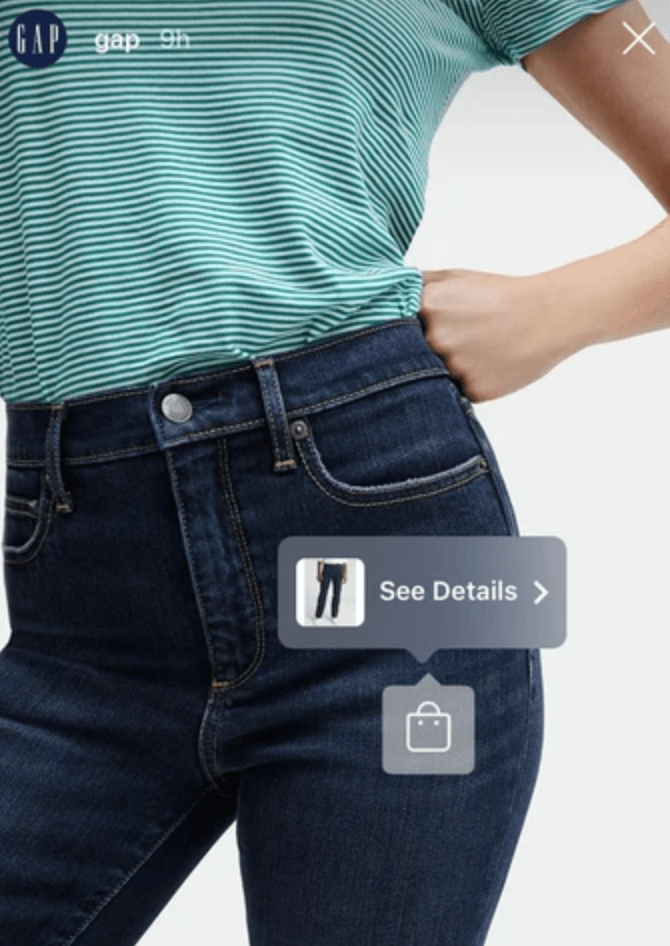
Product stickers are only available to businesses in certain countries. If you’re based in one of these markets, you can use the stickers with images, videos, highlights, and even swipe-ups.
Instagram Shop product pages feature everything a user might want to know before purchasing an item, including:
- The name of the product
- Product images
- A product description
- The price of the product
- A link to view the product on your website
- Related products
3 Key Benefits to Setting Up an Instagram Shop
As mentioned, Instagram is fast becoming an ecommerce powerhouse.
Shari Lott, founder and CEO of kids apparel brand Spearmint Love, said, “When we launched the feature [Instagram Shop], we experienced a 25 percent increase in traffic and an 8 percent increase in revenue attributable to shopping on Instagram.”
Okay, so Instagram Shops work – but what exactly gives them such power? Here are three key reasons:
1. It Reduces Friction and Makes Shopping Easier for Consumers
There’s a lot of noise online.
With so many businesses competing for attention, it can be extremely difficult to get customers to leave what they’re doing on social media and visit your store.
The solution? Don’t try to get them to come to you – take your store to them.
An Instagram Shop removes friction from the purchasing process by making it easier for shoppers to browse your catalog, check prices, or learn more about a particular product.
Plus, once they’re ready to purchase, they can visit the product page on your website with just one tap.
They can even save the product to come back to later by tapping the label icon on a product page – here’s an example from sunglasses brand Shwood:
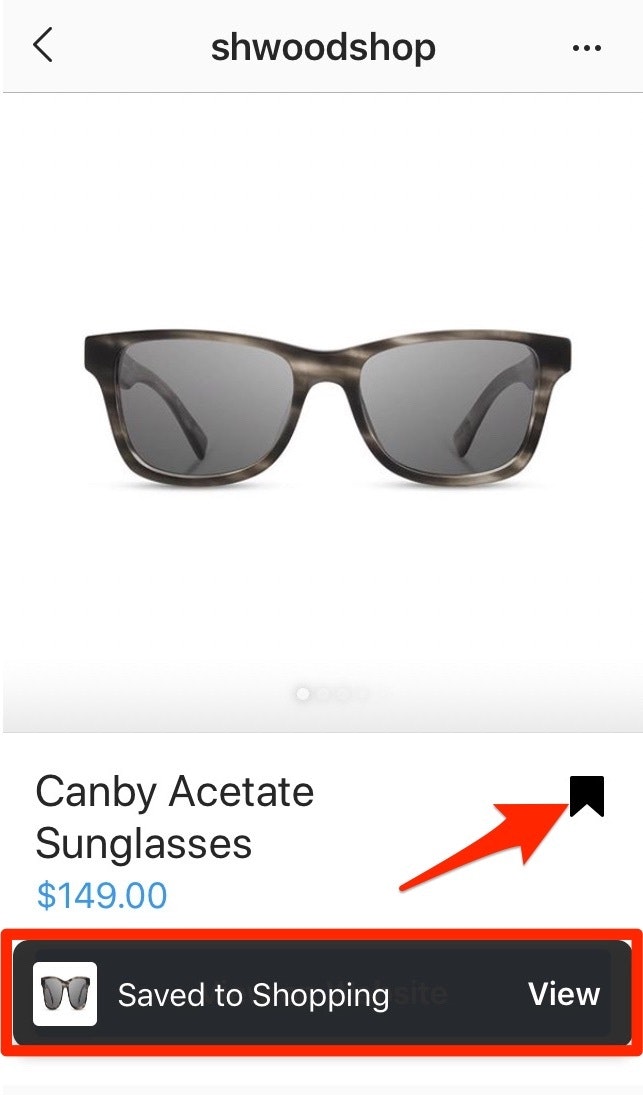
Instagram’s new checkout feature further enhances the shopping experience.
Shoppers can tap it to choose from various articles, sizes and colors, and then proceed to payment — without leaving Instagram.
And after they place their first order, their information (name, email, billing information, and shipping address) is saved in Facebook’s database, allowing you to send them notifications about processing and delivery.
2. It Allows You to Promote Products Directly
Instagram has always been a fantastic place to connect with your target audience and deepen customer relations.
However, Instagram hamstrung businesses by only allowing them to have one measly link on their profile. Still, to this day, you can’t add clickable links to Instagram post descriptions.
This made it extremely difficult to promote individual products.
For example, if you feature a product in a post, your call-to-action would have to point viewers to the link in your bio – which increases friction and massively hurts your conversion rate.
It gets worse.
Remember, you only get one link in your bio.
Sure you can update each time you share a new post, but what about all of your previous posts that no longer have a link to your store?
Enter the Instagram Shop.
An Instagram Shop lets you seamlessly integrate all of your Instagram content with your store. This is awesome – especially when 65 percent of top-performing brand posts feature a product of some kind.
Now, you can weave your product promotions into your posts and Stories and avoid the annoyance of nagging your followers to “Click the link in our bio!”
Savannah Boysen, marketing manager at Tyme, said, “It’s a clean and simple way to show your product in a lifestyle setting, without affecting the user experience.”
It’s easy to use too.
As Instagram explains, “Once a business has a product catalog connected to their account, tagging a product is as simple as tagging a person in a post.”
3. Expose Your Products to Users with a High Purchase Intent
When you tag a product in a post, that post will be included in Instagram’s new Shopping Explore tab.
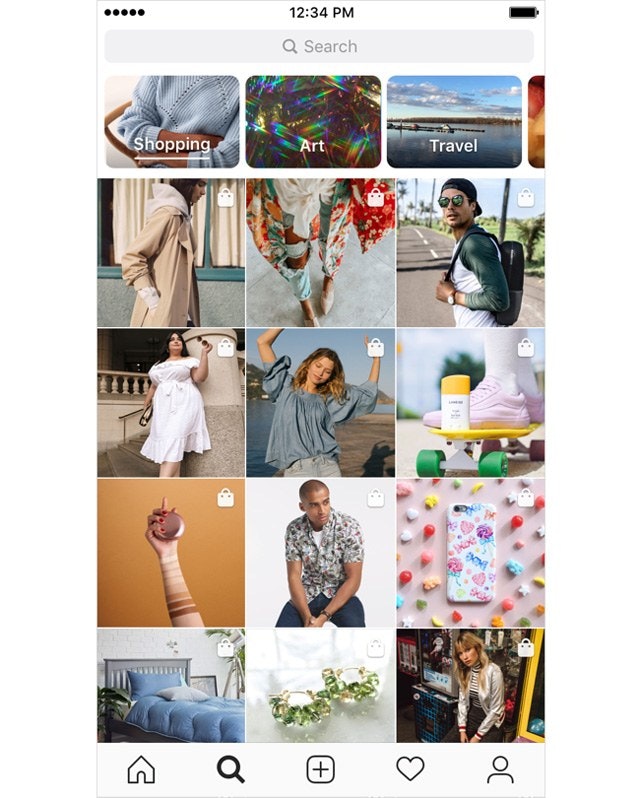
By increasing Instagram engagement through practices like optimizing your hashtags, you can get your products to appear in the Shopping Explore tab.
You’ll also be exposing your products to your target market because these shopping posts are personalized and based on users’ interests and past engagement.
This is fantastic because users viewing the Shopping Explore tab tend to have a high purchase intent.
In other words, they’re likely to buy.
Think of it this way: Aside from the occasional window shopper, it’s fair to say that most people go shopping to, well, shop.
The same is true of the Shopping Explore tab.
These users could be browsing photos of koala bears – but they’re not. Instead, they’re actively choosing to browse Instagram Shop posts. This is an opportunity to attract their attention while they’re in “buying” mode. Major brownie points if you can get your products on their wishlist.
Bottom line, Instagram Shops are a powerful way to boost your sales. So how can you start an Instagram Shop?
How to Start an Instagram Shop for Your Store
To start an Instagram Shop, you first need a Facebook Shop. This is because Instagram actually pulls your product information from Facebook to create your Instagram Shop.
There are a few moving parts that you need to integrate and it can take time for Instagram to approve your account. However, as you now know – it’s totally worth the hassle.
So let’s dive in.
There are two main ways to create a Facebook Shop:
Facebook Shop Option 1: Create a Standalone Facebook Shop
information to your Facebook business page.
Depending on the country your business is based in, you might also be able to manage your orders and take payments on Facebook directly.
We don’t recommend this.
Firstly, Facebook’s ecommerce manager isn’t great and you’ll lack many of the awesome features that are commonplace in a dedicated ecommerce platform provider.
Secondly, it’s likely you already have a website for your store. So, if you create a standalone Facebook Shop, you would have to manage two separate stores with two sets of orders. This means tracking inventory can get extremely complicated.
Instead, we recommend option two:
Facebook Shop Option 2: Sync Your Ecommerce Website to Your Facebook Page
When using a solution like Shopify, you can simply sync your entire product catalogue with Facebook – this means there’s no need to manually create product listings.
Plus, this way, inventory tracking is automatic and you can manage all of your Facebook Shop orders from your Shopify dashboard.
It keeps things simple and far less time consuming. That way, you can focus on the important stuff like growing your sales.
For this reason, this guide will show you how to create a Instagram Shop that seamlessly integrates with your Shopify ecommerce website.
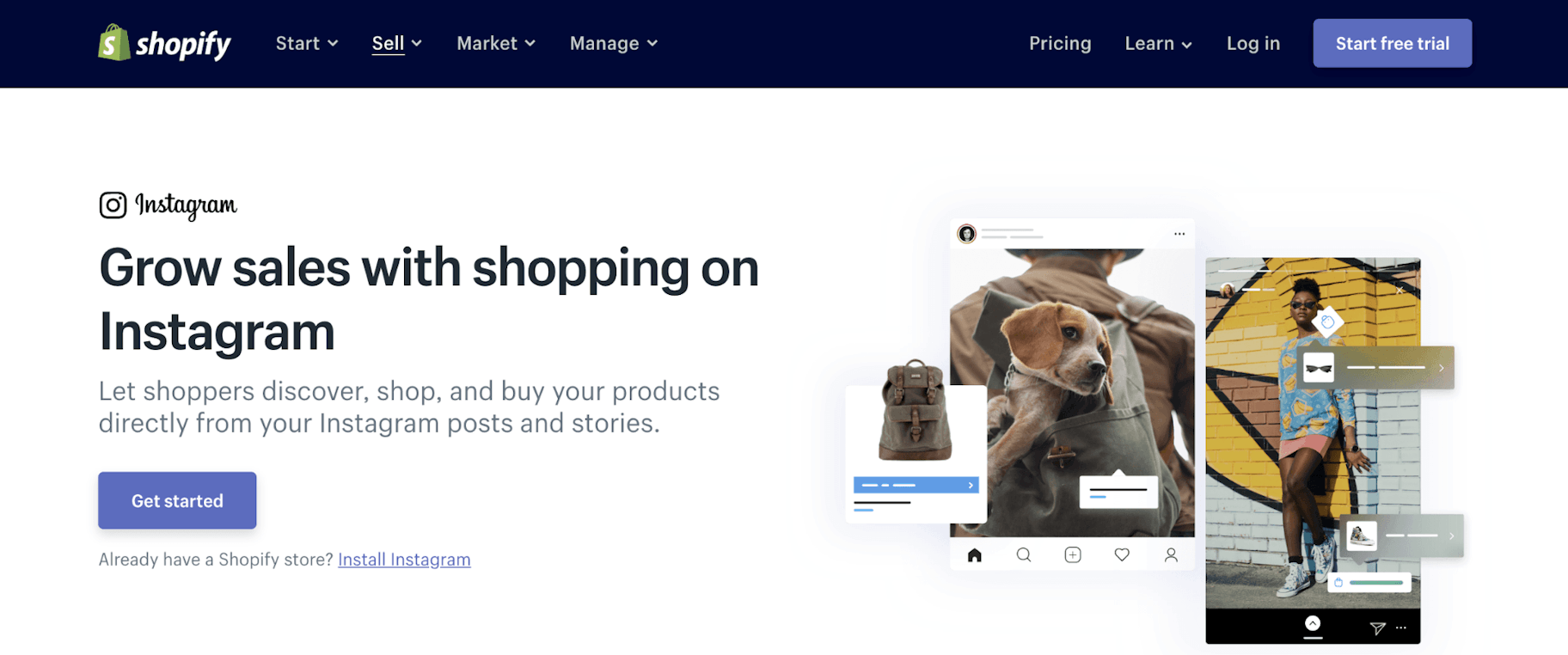
Sound good?
In short, to set up an Instagram Shop you need to connect and sync these three things:
- Shopify Store
- Facebook Page/Shop
- Instagram Business Profile
Alright, let’s dive into the nuts and bolts.
Turn your Instagram into a growth machine
Grow a loyal following, create killer content, and smash your business goals with our Instagram course.
BUILD YOUR INSTAGRAM EMPIRESteps to Set Up Your Instagram Shop
Step 1: Meet The Eligibility Requirements and Lay the Groundwork
Before you can start an Instagram Shop, you need to meet all of Instagram’s requirements.
To start, you can’t use an Instagram Shop to sell services, only eligible physical goods. Plus, your business must comply with Instagram’s commerce policies.
Your business must also be located in a country with access to the feature. To see a list of the countries with access to the Instagram Shop feature, as well as the countries it’s gradually being rolled out to, visit Instagram’s Shop page here.
Now, you need to make sure you have the latest version of the Instagram app to use the Instagram Shop feature.
If you do, you should see the little shopping bag icons on shoppable posts:
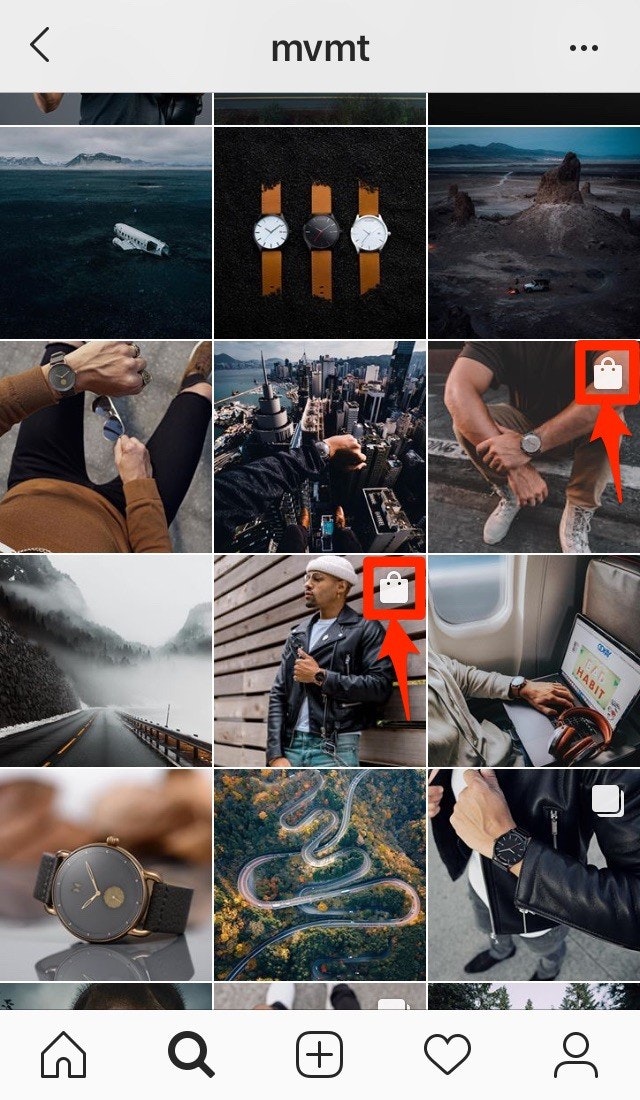
If you don’t see any Instagram Shop tags when using the app, head to your device’s settings to update the app.
Next, to start an Instagram Shop, you must have an Instagram business profile.
Thankfully, it only takes a minute to convert your Instagram profile to a business profile. Plus, you’ll gain access to other business tools, such as Action Buttons, Instagram Insights, and Instagram ads.
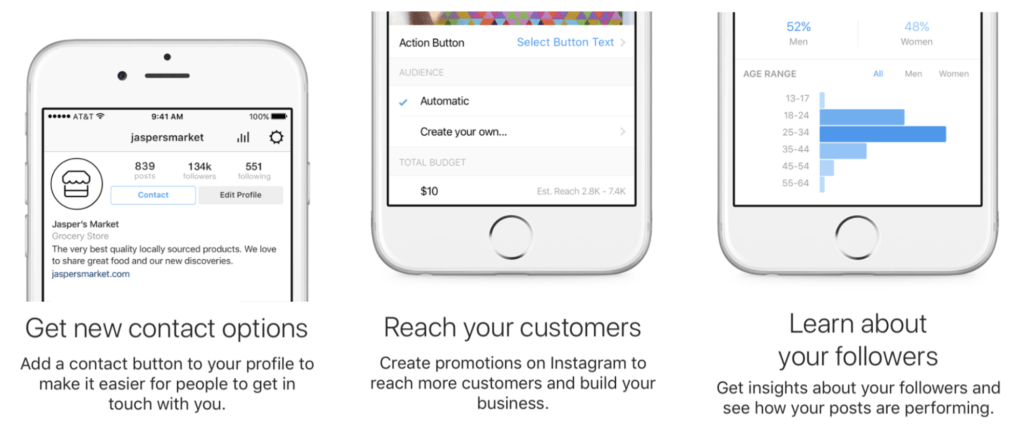
To do this, head to Instagram’s settings:
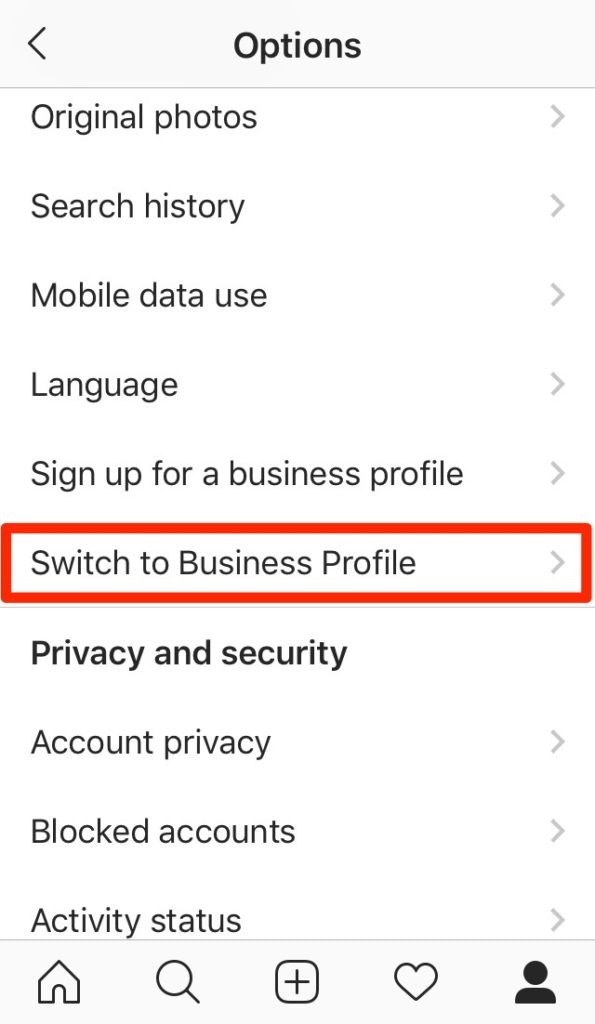
You also need to link your Instagram business profile to your Facebook business page – to do this, you must be a Facebook page admin.
Once again, you can do this in Instagram’s settings:
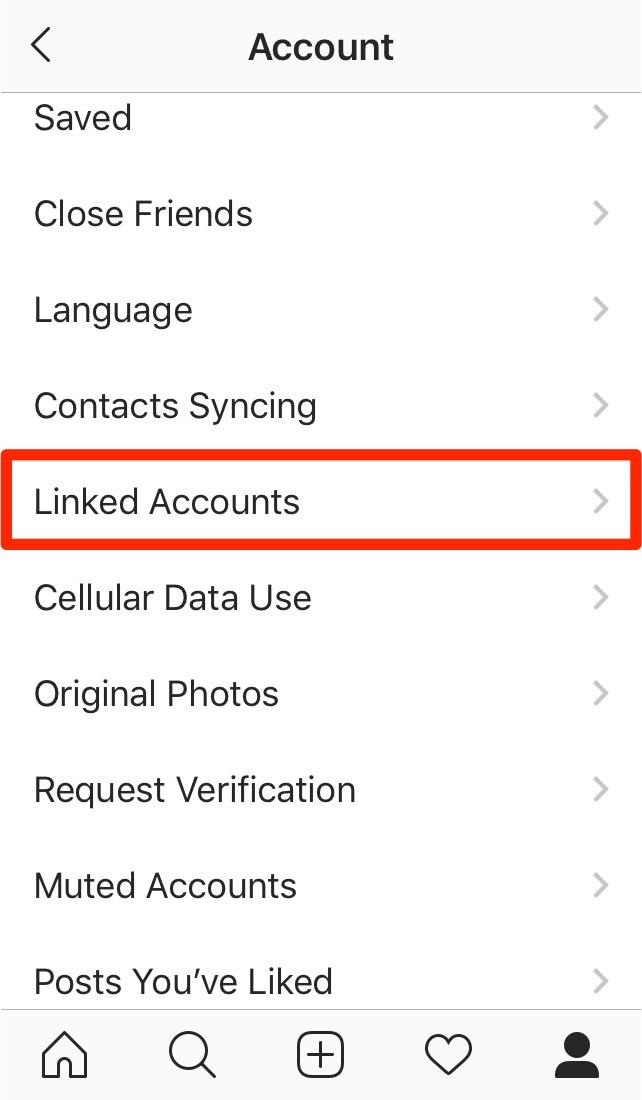
For more detailed instructions on how to convert to a business profile and link it to your Facebook page, read the guide: How to Optimize Your Instagram Profile to Skyrocket Growth.
Okay, all done?
Step 2: Add your Product Catalog to your Facebook Shop
Remember, Instagram Shops pull product information from Facebook Shops.
So, now that your Instagram account is linked to your Facebook page, you need to create a Facebook shop and sync your product catalog to it.
This will also allow you to promote your products directly on Facebook. Here’s an example of a Facebook Shop product page from makeup brand KKW Beauty:
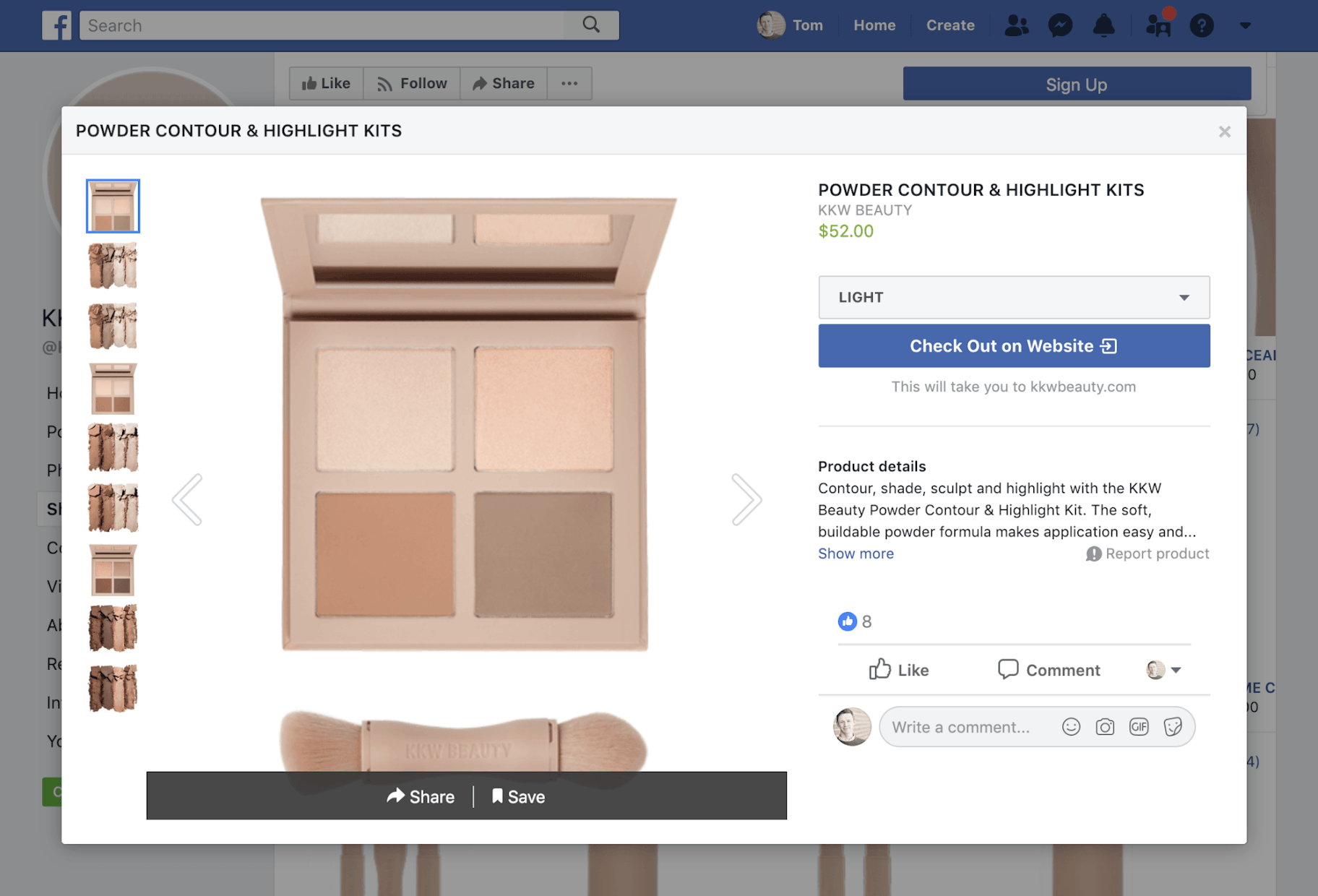
If you haven’t already, you first need to create a Shopify store and add some products to it.
Then, to connect your Shopify store with your Facebook page, click the plus icon next to “Sales Channel” in the left-hand sidebar within the Shopify dashboard.
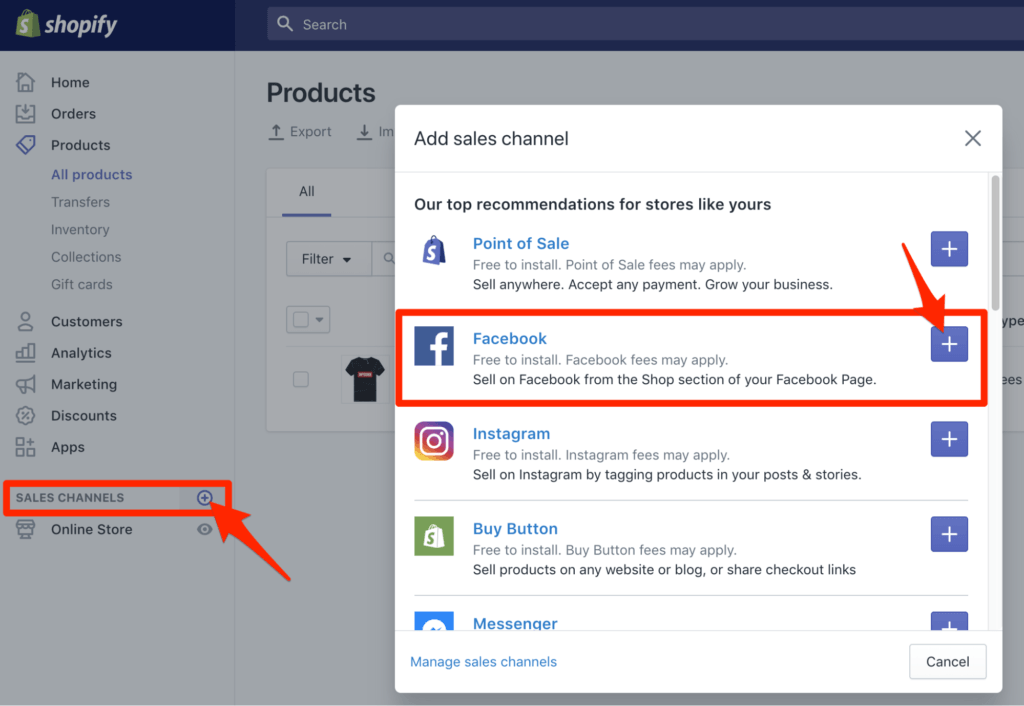
Once your accounts are connected, you need to add your product catalog to Facebook.
To do this, head to the product manager in the Shopify dashboard, select your products, click “Make Products Available” in the dropdown menu, and select Facebook.
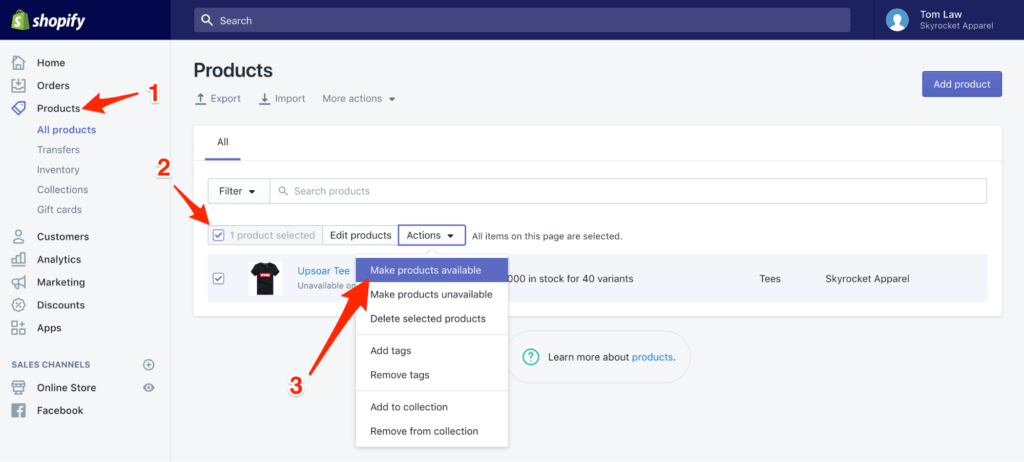
For detailed instructions on how to setup your Facebook Shop, check out our full guide: How to Set Up a Facebook Shop: The Quickstart Guide for Beginners
Step 3: Set Up the Instagram Sales Channel
Next, you need to set up Instagram as a sales channel in the Shopify dashboard in the same way.
Again, just click the plus icon to add a sales channel, then add Instagram:
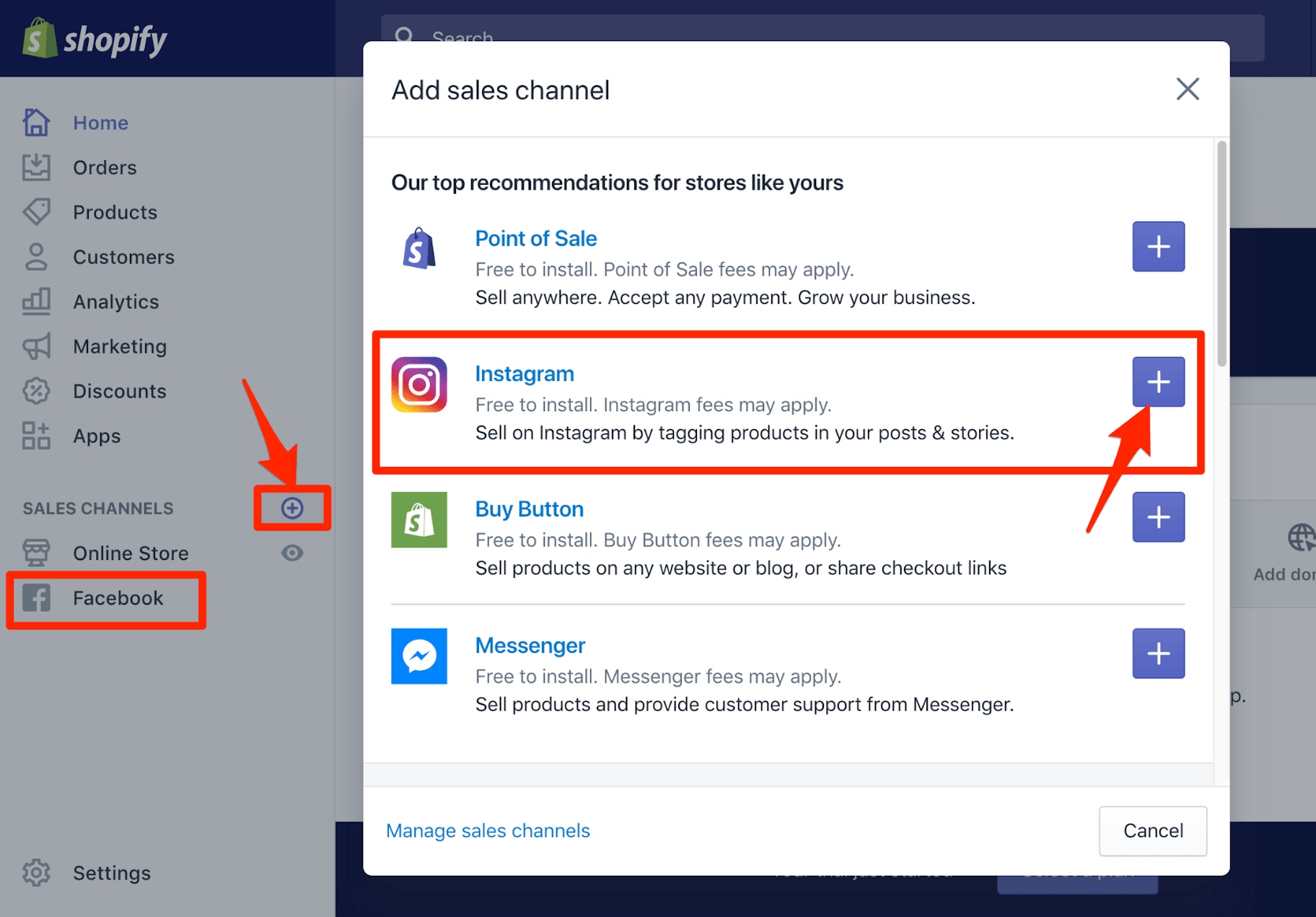
Step 4: Wait for Your Account to Be Approved
Okay, at this point you should have:
- Converted your Instagram profile to a business profile.
- Linked your Instagram business profile to your Facebook business page.
- Linked your Shopify store with your Facebook page.
- Created a Facebook Shop and synced your products to it.
- Linked your Shopify store with your Instagram account.
All done? Awesome – it’s all downhill from here!
Now that you have a Facebook shop linked to your Instagram profile, Instagram will automatically review your account before allowing you to create an Instagram Shop.
Sit tight.
The review process can take a few days and Instagram notes that the process can take longer.
When your account has been approved, Instagram will show you a notification:
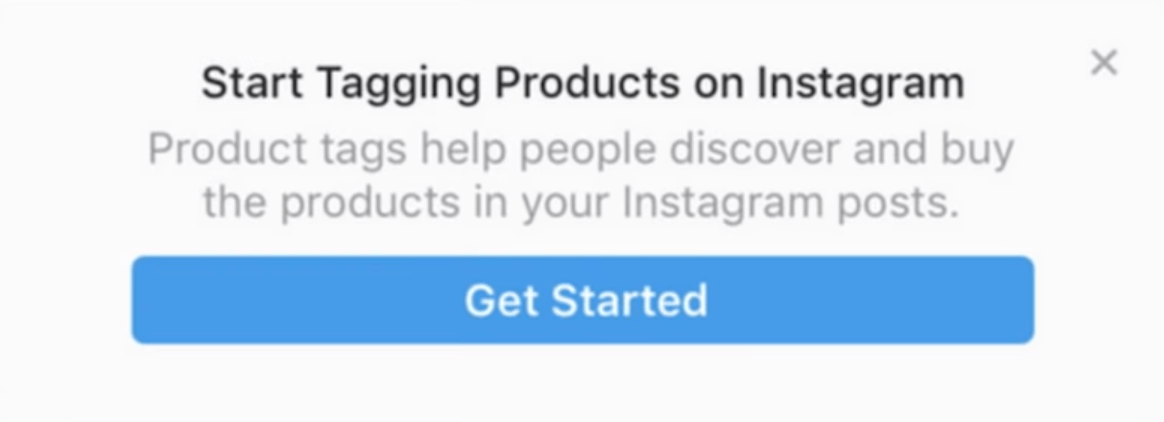
Step 5: Confirm Which Facebook Shop to Add to Instagram
Once you receive the approval notification, all you need to do is confirm which Facebook Shop you want to connect to your Instagram profile.
To do this, tap “Get Started” on the notification or head to Instagram’s business settings and tap “Shopping.”
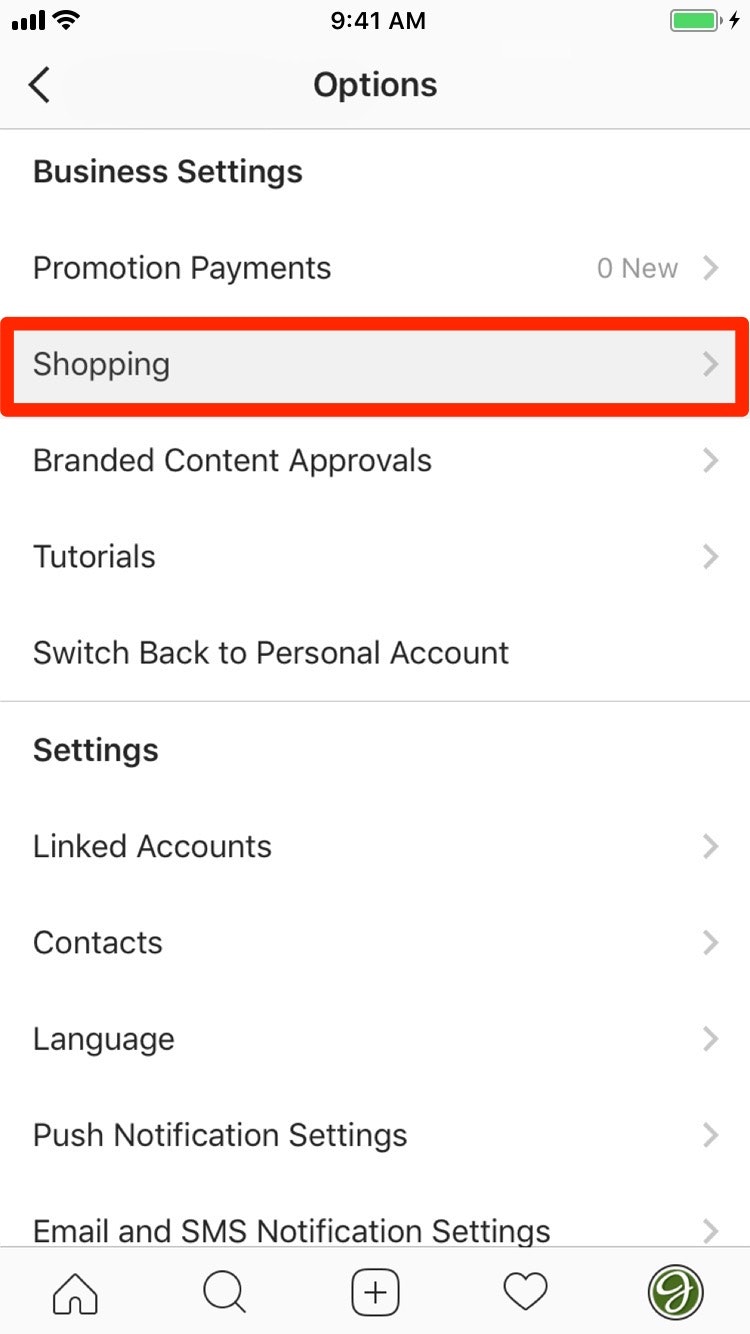
Then, simply select the Facebook Shop you want to use with your Instagram profile.
Now, all of your products are synced across Instagram, your Facebook Shop and your Shopify store.
Congratulations, you now have an Instagram Shop!
Step 6: Tag Your Products in Your Instagram Posts and Stories
Now that you’re all set up, you can begin tagging your products in posts and Instagram Stories.
Even if it was a bit of a maze getting here, this part couldn’t be simpler.
When you create an Instagram post, you can now tag your products in the same way that you usually tag people:
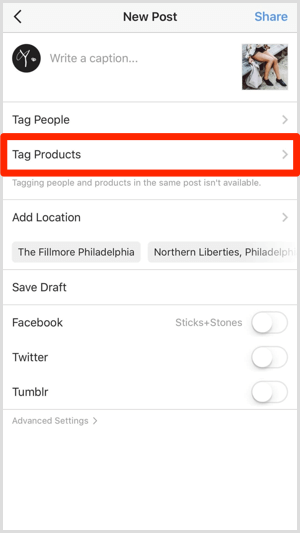
Then, your posts will include the shopping bag icon and shopping tags for the products featured in your posts. Here’s an example from apparel brand Finisterre:
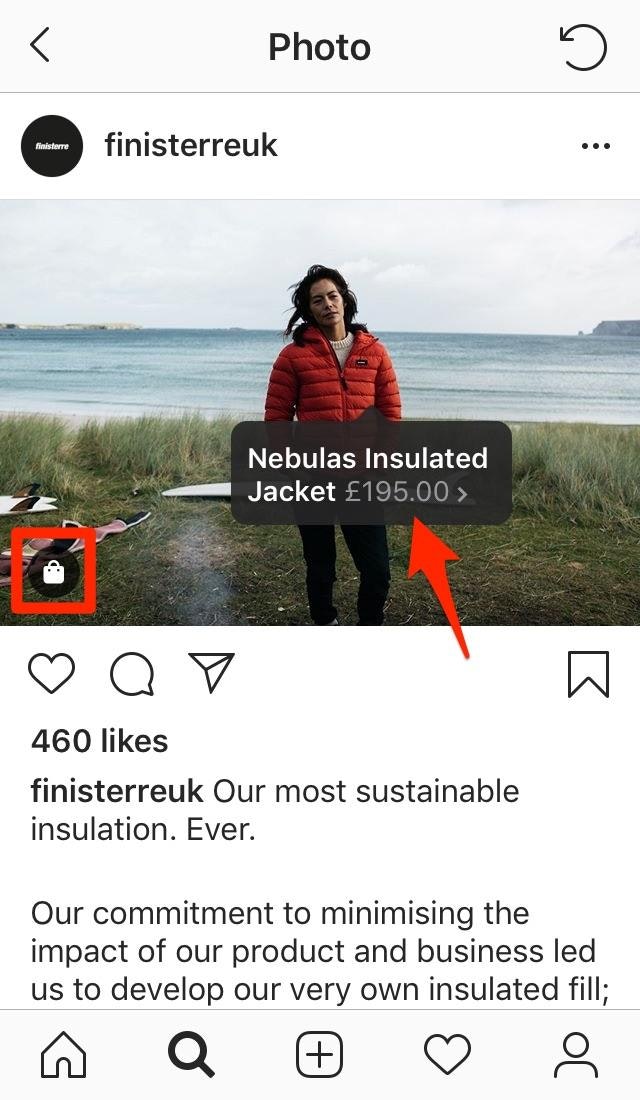
As a reminder, Instagram allows you to tag up to five products per single image or up to 20 products per multi-image post.
It’s also worth noting that you need to create at least one Instagram Shop post to activate the “Shop” tab on your business profile:

How to Promote Your Shop on Instagram
An Instagram Shop won’t do anything on its own. You have to place it in front of a relevant audience in order to make people aware of your products. Here are a few tips:
As for regular posts, Instagram hashtags are an effective strategy for boosting the discoverability of your content.
Not to mention, they can help you appear in the Search & Explore tab, which has an exclusive “Shop” section and is used by more than half of Instagrammers each month.
Plus, if a group of shoppers decide to follow your hashtags, you get a free marketing channel that you could use anytime to reach out to that audience.
Eiger Adventure, for example, captures the interest of people by using niche hashtags in its shopping posts.

To learn more about how to use hashtags gain traction on Instagram, revisit the post: How to Optimize Your Instagram Profile to Skyrocket Growth.
2. Leverage the Product Sticker Feature in Instagram Stories
To tag products in Instagram Stories, simply use the “Product” sticker. The app allows you to pick from 4 different sticker styles: a sticker with the product name in grey or rainbow, translucent text, and a shopping bag icon (the most popular style). You can even edit the sticker’s color and text.
What’s more, you can tag products in both new and existing posts.
So to get the most from your Instagram Shop, it’s worth revisiting your previous posts and tagging products where appropriate.
Unfortunately, you can’t edit Stories that have been published. So if you forget to add a product sticker, you’ll need to delete the Story and re-publish it.
3. Run Instagram Shopping Ads
Instagram has also introduced the option to run organic shopping posts as ads.
People who tap on these ads will be taken to an item description page on Instagram and can proceed to buy from your mobile shop.
To set up an Instagram Shopping Ad, open your Facebook Ads Manager and follow these steps:
- Click “+Create” and select an objective from “reach, brand awareness, link clicks, post engagement, or conversions.”
- Choose the audience that you wish to target. (here’s a detailed guide to audience targeting)
- Select “Edit placements” and choose “Instagram Feed” as the only place where you wish to run your ads.
- During ad set customization, choose “Use Existing Post.”
- Select the Shopping content you’d like to run as an ad.
- Complete the information for your ad and click “Continue.”
Pro tip: Make sure the posts you run as ads include high-quality images, descriptive hashtags, and accurate tags. That’ll make consumers more receptive towards your business.
Summary: Guide to Setting Up an Instagram Shop
Although an Instagram Shop can be a pain to set up, the effort is well worth it.
Integrating your store with Facebook and Instagram is a powerful way to grow your ecommerce store.
Remember, to start an Instagram Shop you need to:
- Convert your Instagram profile to a business profile.
- Link your Instagram business profile to your Facebook Page.
- Link your Shopify store to your Facebook page.
- Create a Facebook Shop by syncing your products from your Shopify store.
- Link your Shopify store with your Instagram account.
- Wait to be approved by Instagram and then select the Facebook Shop you want to use with your Instagram account.
- Start selling on Instagram!
Have you set up an Instagram Shop for your store? Let us know in the comments below!
Want to Learn More?
FAQs on Setting Up an Instagram Shop
How do I set up an Instagram Shop?
Setting up an Instagram store is an easy five-step process:
- Switch your Instagram profile to a business profile
- Link your Instagram business profile to your Facebook business page
- Link your Shopify store to your Facebook business page
- Create a Facebook shop and sync your products
- Link your Shopify store to your Instagram account
Is Instagram Shop free?
Yes, Instagram Shopping is completely free to use. All you need to get started is a Facebook business page and an Instagram business profile (both of which are free) and connect the two.
After that's done, simply upload your business product catalog, turn on the Shopping feature, and you're ready to start selling on Instagram.
What is Instagram store?
Instagram store, also known as Instagram Shopping, is a feature that allows businesses on Instagram to incorporate their product catalog into their accounts.
In doing so, they can list, promote, and sell their products to Instagram users on the platform itself by creating product pages and tagging their products in their posts and Stories.

